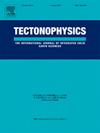Magnetotelluric imaging of the Parnaíba Basin: Implications to the West Gondwana formation
IF 2.6
3区 地球科学
Q2 GEOCHEMISTRY & GEOPHYSICS
引用次数: 0
Abstract
The Parnaíba Basin, in northeastern Brazil, is one of the most significant intracratonic basins on the South American platform. Its formation, driven by vertical thermal and mechanical processes has been extensively studied, however, the internal structural configuration remains subject of debate. Magnetotellurics (MT) is a geophysical method that provides information about the geo-electric internal distribution. As part of the multi-physics Parnaíba Basin Analysis Project (PBAP), 218 broadband and 37 long-period MT stations were deployed along an E-W transect profile of . The MT data were inverted to produce 3-D resistivity models. Lateral resistivity variations were identified along the profile and interpreted as the amalgamation of the three blocks, from west to east: Amazonian Craton, Parnaíba block, and Borborema Province. Within each block, the models reveal differentiated geoelectric behaviours. The Amazonian Craton exhibits a high-conductivity domain associated with the replacement of a delaminated lithosphere. The Parnaíba block comprises two distinct tectonic domains: the resistive Grajaú block and the conductive Teresina block. Their resistivity contrast is associated with magmatic activity, which is more intense in Teresina. However, Cretaceous extensional events related to the opening of the South Atlantic may have also influenced it. In the Borborema Province, resistive and conductive signatures at lower crustal depth are identified, providing evidence of collisional events associated with its formation in the Neoproterozoic. These deep resistivity models provide new evidence for the crustal amalgamation of the Parnaíba Basin and offer insights into the tectonic processes that shaped Western Gondwana.
Parnaíba盆地大地电磁成像:对西冈瓦纳组的启示
Parnaíba盆地位于巴西东北部,是南美洲台地上最重要的克拉通内盆地之一。它的形成是由垂直的热和机械过程驱动的,已经被广泛研究,然而,内部结构构型仍然是争论的主题。大地电磁学(MT)是一种提供地电内部分布信息的地球物理方法。作为多物理场Parnaíba盆地分析项目(PBAP)的一部分,沿东西向样带剖面部署了218个宽带站和37个长周期MT站。对大地电磁法数据进行反演,得到三维电阻率模型。沿剖面确定了横向电阻率变化,并将其解释为三个区块的合并,从西到东:亚马逊克拉通,Parnaíba区块和Borborema省。在每个区块内,模型显示了不同的地电行为。亚马逊河克拉通表现出与分层岩石圈替换有关的高导电性域。Parnaíba地块包括两个不同的构造域:阻性Grajaú地块和导电Teresina地块。它们的电阻率对比与岩浆活动有关,而岩浆活动在特雷西纳更为强烈。然而,与南大西洋打开有关的白垩纪伸展事件也可能对其产生了影响。在borborrema省,识别了地壳下深度的电阻和导电特征,提供了与新元古代形成相关的碰撞事件的证据。这些深部电阻率模型为Parnaíba盆地的地壳合并提供了新的证据,并为塑造西冈瓦纳的构造过程提供了新的见解。
本文章由计算机程序翻译,如有差异,请以英文原文为准。
求助全文
约1分钟内获得全文
求助全文
来源期刊

Tectonophysics
地学-地球化学与地球物理
CiteScore
4.90
自引率
6.90%
发文量
300
审稿时长
6 months
期刊介绍:
The prime focus of Tectonophysics will be high-impact original research and reviews in the fields of kinematics, structure, composition, and dynamics of the solid arth at all scales. Tectonophysics particularly encourages submission of papers based on the integration of a multitude of geophysical, geological, geochemical, geodynamic, and geotectonic methods
 求助内容:
求助内容: 应助结果提醒方式:
应助结果提醒方式:


